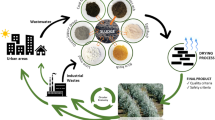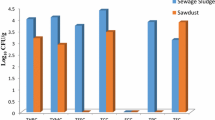Abstract
This study deals with thermal analysis of growing media obtained from mixtures of paper will waste materials (one de-inking paper sludge, HP, and one reject from paper mill producing paper from virgin wood, RT) with sewage sludge. For the growing media formulation, one sewage sludge (L) was mixed with both paper mill waste materials at 10, 20, and 30% in volume. An incubation experiment was designed in order to study their carbon mineralization. Addition of sewage sludge significantly increases the carbon mineralization of growing media based on RT. In case of HP, carbon mineralization increases after addition of sewage sludge in 30% (HP + 30L treatment). Thermogravimetric analysis (TG and DTG) of growing media was performed before and after incubation experiment in order to study the organic matter transformation. The higher the carbon mineralization, the greater the difference between TG curves of samples before and after the incubation. The WL3/WL2 ratio increases after incubation of samples as a result of organic matter stabilisation. For HP growing media, the highest value corresponds to HP + 30L whereas HP + 20L, and HP + 10L show similar values. In case of RT, the WL3/WL2 index shows a progressive increase with sewage sludge content.





Similar content being viewed by others
References
Grigatti M, Giorgioni ME, Ciavatta C. Compost-based growing media: influence on growth and nutrient use of bedding plants. Bioresour Technol. 2007;98:3526–34.
Guerrero F, Gascó JM, Hernández-Apaolaza L. Use of pine bark and sewage sludge compost as components of substrates for pinus pinea and cuppressus arizonica production. J plant nutr. 2002;25:129–41.
Ingelmo F, Canet R, Ibáñez MA, Pomares F, García J. Use of MSW compost dried sewage sludge and other wastes as partial substitutes for peat and soil. Bioresour Technol. 1998;63:123–9.
Ostos JC, López-Garrido R, Murillo JM, López R. Substitution of peat for municipal solid waste and sewage sludge-based composts in nursey growing media: effects on growth and nutrition of the native shrub Pistacia lentiscus L. Bioresour Technol. 2008;99:1793–800.
Méndez A, Fidalgo JM, Guerrero F, Gascó G. Characterization and pyrolysis behaviour of different paper mill waste materials. J Anal Appl Pyrol. 2009;86:66–73.
Chantigny MH, Angers DA, Beauchamp CJ. Aggregation and organic matter decomposition in soils amended with de-inking paper sludge. Soil Sci Soc Am J. 1999;63:1214–21.
Fierro A, Angers DA, Beauchamp CJ. Decomposition of paper de-inking sludge in a sandpit minesoil during revegetation. Soil Biol Biochem. 2000;32:143–50.
Chantigny MH, Angers DA, Beauchamp CJ. Active carbon pools and enzyme activities in soils amended with de-inking paper sludge. Can J Soil Sci. 2000;80:99–105.
Filiatrault P, Camiré C, Norrie JP, Beauchamp CJ. Effects of de-inking paper sludge on growth and nutritional status of alder and aspen. Resour Conserv Recycling. 2006;48:209–26.
Stabnikova O, Goh WK, Ding HB, Tay JH, Wang JY. The use of sewage sludge and horticultural waste to develop artificial soil for plant cultivation in Singapore. Bioresour Technol. 2005;96:1073–80.
Thomas GW. Soil pH and soil acidity. In: Bigham JM, editor. Methods of soil analysis. Part 3. Chemical methods. Madison, Wisconsin: ASA-SSSA; 1996. p. 475–89.
Rhoades JD. Methods of soil analysis: part 3. In: Bigham JM, editor. Methods of soil analysis. Part 3. Chemical methods. Madison, Wisconsin: SSSA; 1996. p. 417–35.
Sumner ME, Miller WP. Cation exchange capacity and exchange coefficients. In: Bigham JM, editor. Methods of soil analysis. Part 3. Chemical methods. Madison, Wisconsin: SSSA; 1996. p. 1201–29.
Nelson DW, Sommers LE. Total carbon, organic carbon and organic matter. In: Bigham JM, editor. Methods of soil analysis. Part 3. Chemical methods. Madison, Wisconsin: SSSA; 1996. p. 961–1010.
Bremner JM. Nitrogen-Total. In: Bigham JM, editor. Methods of soil analysis. Part 3. Chemical methods. Madison, Wisconsin: SSSA; 1996. p. 1085–121.
USEPA. Method 3051a: microwave assisted acid dissolution of sediments, sludges, soils, and oils. 2 ed. Washington: U.S. Gov. Print. Office; 1997.
De Boodt M, Verdonk O. The physical properties of the substrates in horticulture. Acta Hortic. 1972;26:37–44.
Bunt AC. Media and mixes for container grown plants: a manual on the preparation and use of growing media for growing pot plants. 2nd ed. London: Unin Hyman; 1988.
De Boodt M, Verdonk O, Cappaert I. Method for measuring the water-release curve of organic substrates. Acta Hortic. 1974;37:2054–62.
Abad M, Martínez PF, Martínez MD, Martínez J. Evaluación agronómica de los sustratos de cultivo. Actas de Horticultura. 1993;11:141–54.
Díez JA, Polo A, Guerrero F. Effect of sewage sludge on nitrogen availability in peat. Biol Fertil Soils. 1992;13:248–51.
Pietro M, Paola C. Thermal analysis for the evaluation of the organic matter evolution during municipal solid waste aerobic composting process. Thermochimica Acta. 2004;413:209–14.
Dell′Abate MT, Benedetti A, Sequi P. Thermal methods of organic matter maturation monitoring during a composting process. J Therm Anal Calorim. 2000;61:389–96.
Council of European Union, Council Directive of 12 June 1986 on the protection of the environment, and in particular of the soil, when sewage sludge is used in agriculture (86/278/EEC). Official Journal of the European Communities L 330. 1986. p. 6–12.
Hernández Apaolaza L, Guerrero F. Comparison between pine bark and coconut husk sorption capacity of metals and nitrate when mixed with sewage sludge. Bioresour Technol. 2008;99:1544–8.
Abad M, Noguera P, Puchades R, Maquieira A, Noguera V. Physico-chemical and chemical properties of some coconut coir dusts for use as a peat substitute for containerised ornamental plants. Bioresour Technol. 2002;82:241–5.
Hernández-Apaolaza L, Gascó AM, Gascó JM, Guerrero F. Reuse of waste materials as growing media for ornamental plants. Bioresour Technol. 2005;96:125–31.
Inbar Y, Chen Y, Hadar Y, Hoitink HAJ. New approaches to compost maturity. BioCycle. 1990;31:64–8.
Barriga S, Méndez A, Cámara J, Guerrero F, Gascó G. Agricultural valorisation of de-inking paper sludge as organic amendment in different soils: thermal study. J Therm Anal Calorim. 2010;99:981–6.
Hernández-Apaolaza L, Gascó JM, Guerrero F. Initial organic matter transformation of soil amended with composted sewage sludge. Biol Fertil Soils. 2000;32:421–6.
Tuomela M, Vikman M, Hatakka A, Itavaara M. Biodegradation of lignin in a compost environment: a review. Bioresour Technol. 2000;72:169–83.
Zbytniewski R, Buszewski B. Characterization of natural organic matter (NOM) derived from sewage sludge compost. Part 1: chemical and spectroscopic properties. Bioresour Technol. 2005;96:471–8.
Marhuenda-Egea FC, Martínez-Sabater E, Jordá J, Sánchez-Sánchez A, Moral R, Bustamante MA, Paredes C, Pérez-Murcia MD. Evaluation of the aerobic composting process of winery and distillery residues by thermal methods. Thermochimica Acta. 2007;454:135–43.
Som HP, Lemée L, Amblès A. Stability and maturity of a green waste and biowaste compost assessed on the basis of a molecular study using spectroscopy, thermal analysis, thermodesorption and thermochemolysis. Bioresour Technol. 2009;100:4404–16.
Gómez X, Cuetos MJ, García AI, Morán A. An evaluation of stability by thermogravimetric analysis of digestate obtained from different biowastes. J Hazard Mater. 2007;149:97–105.
Baffi C, Dell′Abate MT, Nassisi A, Silva S, Benedetti A, Genevini PL, Adani F. Determination of biological activity in compost: a comparison of methodologies. Soil Biol Biochem. 2007;39:1284–93.
Author information
Authors and Affiliations
Corresponding author
Rights and permissions
About this article
Cite this article
Méndez, A., Barriga, S., Guerrero, F. et al. Thermal analysis of growing media obtained from mixtures of paper mill waste materials and sewage sludge. J Therm Anal Calorim 104, 213–221 (2011). https://doi.org/10.1007/s10973-010-1227-5
Published:
Issue Date:
DOI: https://doi.org/10.1007/s10973-010-1227-5




